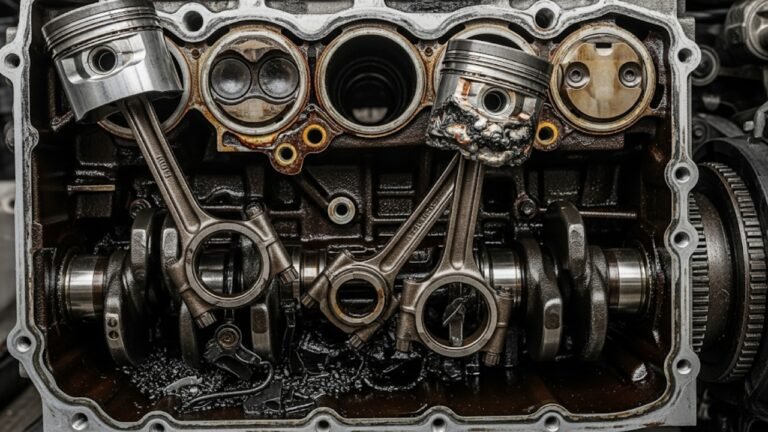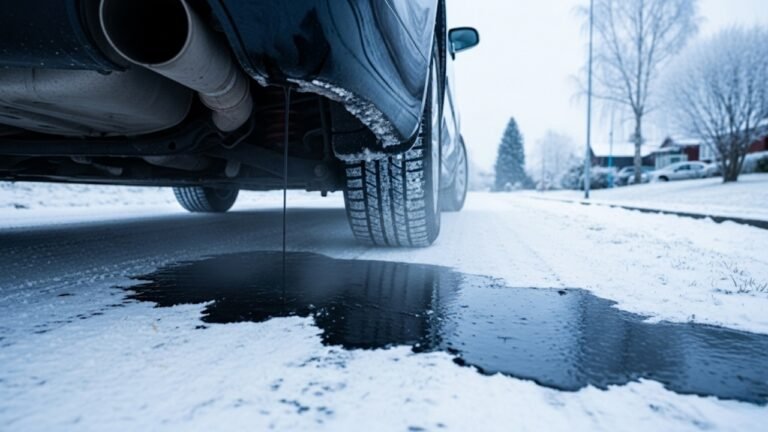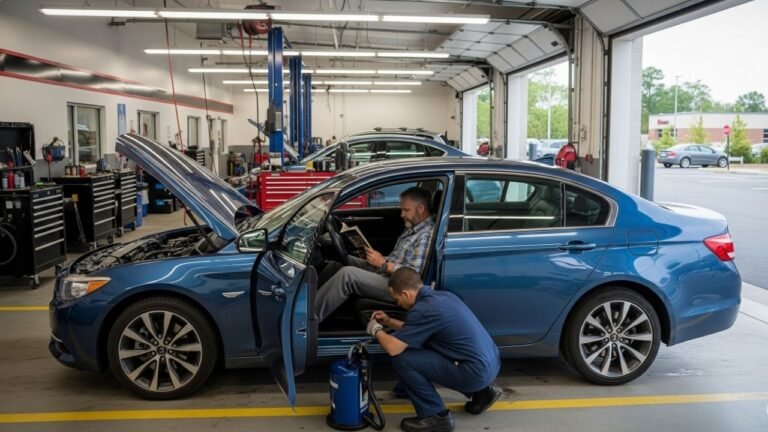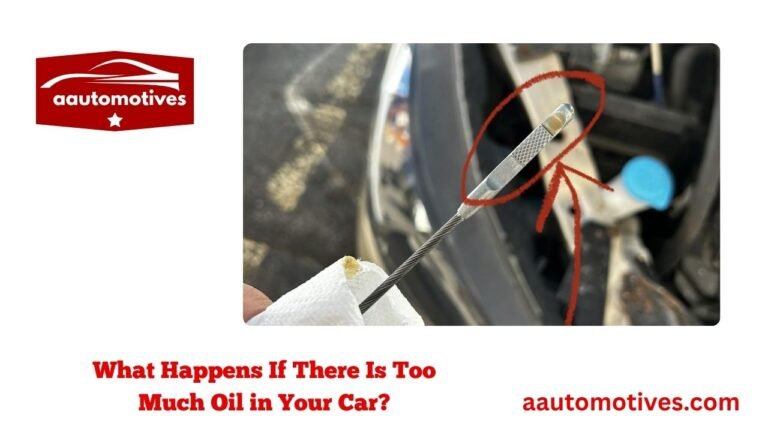What Does It Mean When Your Car Say Low Oil Pressure?

We’ve all had that moment. You’re cruising down the road, maybe listening to your favorite playlist or just zoning out after a long day—and then suddenly, a little warning blinks on the dashboard. It reads: “Low Oil Pressure.” Your stomach drops.
“What does it mean when your car say low oil pressure?” you wonder, heart skipping a beat.
If that’s you right now, take a deep breath. You’re not alone—and this article is here to guide you through every detail. Whether you’re a curious driver or a concerned car owner, we’re going to break this down into easy-to-understand bits. No confusing jargon. Just real talk, honest advice, and solid info—served with a side of empathy.
Let’s pop the hood on this issue, shall we?
In This Article
- 1 What Does It Mean When Your Car Say Low Oil Pressure?
- 2 Why Oil Pressure Is So Important (And What It Does)
- 3 Common Causes of Low Oil Pressure: The Hidden Triggers
- 4 Real-Life Scenario: My Friend’s Close Call
- 5 How to Check for Low Oil Pressure Like a Pro
- 6 The Role of Engine Oil Type: Not All Oils Are Equal
- 7 Driving Habits That Can Affect Oil Pressure
- 8 Fixing the Issue: What You Can Do Long-Term
- 9 Cost Breakdown: What You Might Pay
- 10 How to Prevent Low Oil Pressure: Real-World Tips
- 11 Car-Specific Oil Recommendations (Sample Table)
- 12 Frequently Asked Questions (FAQs)
- 12.1 ❓1. Is it safe to drive with low oil pressure?
- 12.2 ❓2. Can low oil pressure cause engine knocking?
- 12.3 ❓3. Will adding oil fix the problem?
- 12.4 ❓4. How do I know it’s not just a faulty sensor?
- 12.5 ❓5. How often should I check oil levels?
- 12.6 ❓6. Can the warning light reset itself?
- 12.7 ❓7. Does synthetic oil reduce the risk of low oil pressure?
- 12.8 ❓8. What happens if I ignore low oil pressure too long?
- 13 ❤️ Final Thoughts: Your Engine’s Heartbeat Matters
What Does It Mean When Your Car Say Low Oil Pressure?

Here’s what the warning usually means:
-
The oil pump may not be working well.
-
Your engine oil level might be dangerously low.
-
The oil filter could be clogged.
-
There may be a leak or internal engine problem.
Without proper oil pressure, engine components rub together without protection. Friction builds up. Heat increases. And eventually, things can grind to a halt—literally.
Let’s explore why this happens and what you should do about it.
Why Oil Pressure Is So Important (And What It Does)
Oil is like the lifeblood of your car’s engine. It moves through small passages and lubricates everything, so parts don’t scrape and wear down. The pressure created by the oil pump keeps this flow consistent.
Think of it like a small river running through a valley. If the river dries up, the land cracks, the animals leave, and everything suffers. Same with your engine.
Here’s what proper oil pressure helps with:
-
Reduces friction between metal parts
-
Cools engine components by carrying away heat
-
Prevents corrosion inside the engine
-
Extends the engine’s lifespan
So when the pressure drops? It’s a code red situation.
Common Causes of Low Oil Pressure: The Hidden Triggers
You might be surprised by how many different things can cause low oil pressure. Here’s a deep dive into the most common ones:
1. Low Oil Level
Maybe you haven’t checked it in a while. Or there’s a slow leak somewhere. Either way, if the oil level drops, there’s less to circulate, and the pressure tanks.
2. Worn Engine Bearings
Over time, parts like crankshaft or camshaft bearings wear down. This increases the clearance and lowers oil pressure, especially when the engine’s hot.
3. Oil Pump Failure
A bad oil pump can’t push oil through the engine properly. This is like your heart not beating hard enough. Oil flow slows. Damage builds.
4. Clogged Oil Filter
If the filter is blocked, it can choke the flow of oil. This reduces the pressure and leads to engine starvation—bad news.
5. Using the Wrong Oil Viscosity
Too thick or too thin? Oil viscosity matters. If it’s wrong for your climate or engine type, it won’t flow or pressurize the way it should.
6. Faulty Oil Pressure Sensor
Sometimes, the warning isn’t about the oil at all—but a bad sensor sending false signals. Still, never assume it’s just a glitch.
Common Triggers Table
| Problem | Cause | Severity |
|---|---|---|
| Low Oil Level | Leak or overdue oil change | Critical |
| Clogged Oil Filter | Skipped oil change or dirty oil | Dangerous |
| Oil Pump Failure | Wear and tear | ❗ Urgent |
| Wrong Oil Viscosity | Incorrect oil type for your engine | ⚠️ Moderate |
| Worn Engine Bearings | High mileage or poor maintenance | Serious |
| Faulty Sensor | Electronic or wiring fault | Check First |
Real-Life Scenario: My Friend’s Close Call
Let me tell you a quick story. My buddy Tanvir had a 2012 Toyota Corolla. One day, the low oil pressure light blinked on during a Dhaka traffic jam. He thought it was just a fluke and kept driving. Bad idea.
Within minutes, he heard a loud knocking sound. Then smoke. The engine seized—and he had to replace the whole thing. A small light turned into a Tk 150,000 mistake. Trust me, it’s not worth the risk.
So when you see that warning, don’t ignore it.
How to Check for Low Oil Pressure Like a Pro
Want to take control before things get worse? Here’s a simple step-by-step checklist to follow:
-
Pull Over Immediately
Stop the car as soon as it’s safe. Driving can cause permanent damage if the pressure is truly low. -
Turn Off the Engine
Let it cool. Never check oil with a hot engine—it can burn you. -
Check the Oil Level
Use the dipstick. If it’s low, top it up with the right type of oil. -
Look for Leaks
Check under the car or around the engine. Oil puddles? Wet spots? Bad news. -
Restart and Recheck
If the light stays on, call a mechanic or tow the vehicle.
This kind of quick reaction can save your engine—and your wallet.
The Role of Engine Oil Type: Not All Oils Are Equal
One often overlooked reason behind that low oil pressure warning is the type of oil you use. Just like you wouldn’t use coconut oil to fry chicken wings (at least not well!), using the wrong viscosity oil in your car can cause major problems.
For example:
-
If you use 5W-30 instead of 10W-40, your engine might not get enough oil pressure, especially in hot weather.
-
Synthetic oils flow differently than conventional ones. If your car needs synthetic, don’t cut corners.
Important Note:
Always follow your car’s owner’s manual when choosing oil. It’s like the doctor’s prescription for your engine.
Driving Habits That Can Affect Oil Pressure
Believe it or not, how you drive can also influence your oil pressure levels. Here’s how:
-
Hard acceleration can push oil away from vital areas.
-
Riding with low RPMs in high gears can starve the engine of oil.
-
Long intervals between oil changes cause sludge buildup.
-
Towing heavy loads without enough oil causes overheating.
Think of it this way: drive gently, treat your engine with kindness, and it’ll return the favor.
Fixing the Issue: What You Can Do Long-Term
So, you saw the low oil pressure warning, maybe even felt the panic, and handled the immediate steps. That’s great. But now comes the important part—making sure it doesn’t happen again.
Depending on the cause, the long-term fix can vary. Sometimes it’s just an oil change. Other times, it’s engine surgery.
Let’s break it down:
✅ If it’s Low Oil Level:
-
Top up the oil.
-
Inspect for leaks under the vehicle and near the oil pan.
-
Make sure your oil filter is tightly secured.
✅ If it’s Worn Engine Bearings:
-
This usually requires a mechanic’s diagnosis.
-
Replacing engine bearings is a costly repair (often $500–$2,000+).
-
Sometimes it’s better to rebuild or replace the engine, especially if the damage is widespread.
✅ If the Oil Pump is Bad:
-
This part costs around $300–$600, plus labor.
-
It must be replaced ASAP to restore pressure.
✅ If the Sensor is Faulty:
-
Oil pressure sensors are cheap—often under $100.
-
But be cautious: don’t assume it’s the sensor unless confirmed.
✅ If You Used the Wrong Oil:
-
Drain the oil.
-
Flush the engine if needed.
-
Refill with the correct viscosity as per your owner’s manual.
Always have a trusted mechanic look things over if you’re unsure. You don’t want to play guessing games with your engine’s life.
Cost Breakdown: What You Might Pay
It helps to know what kind of expense you’re facing. Here’s a quick table that breaks down repair costs based on the cause of the low oil pressure warning:
| Repair Type | Estimated Cost (USD) | Urgency |
|---|---|---|
| Oil Change & Filter | $40 – $120 | Low (if just dirty oil) |
| Oil Pressure Sensor | $80 – $180 | Medium |
| Oil Pump Replacement | $400 – $900 | High |
| Fixing Oil Leaks | $150 – $600 | High |
| Replacing Bearings | $800 – $2,500+ | Very High |
| Engine Replacement | $2,500 – $6,000+ | Catastrophic |
These numbers can change based on the car model, labor rates, and parts availability—but they give you a solid picture of what to expect.
How to Prevent Low Oil Pressure: Real-World Tips
Like many things in life, prevention is cheaper than repair. Just like brushing your teeth keeps you from a painful root canal, caring for your oil system can save your engine.
Here are some honest and effective tips to avoid seeing that dreaded dashboard message again:
Regular Maintenance
-
Change your oil every 5,000 to 7,000 km, or as the manual suggests.
-
Use OEM oil filters, not the cheapest ones on the shelf.
-
Check the oil every 2–3 weeks if you drive a lot.
Use High-Quality Oil
-
Stick to the recommended viscosity (e.g., 5W-30, 10W-40).
-
Synthetic oil is better in hot climates or heavy-use vehicles.
Warm Up Gently
-
Don’t rev a cold engine. Let it idle for 30–60 seconds first.
-
Avoid flooring the accelerator until the oil reaches optimal temp.
Keep the Engine Clean
-
Engine sludge kills oil flow. Use engine flushes occasionally, especially in older cars.
-
Watch for the Check Engine light too—it can relate to oil pressure.
Car-Specific Oil Recommendations (Sample Table)
Here’s a useful reference table for some popular models:
| Car Model | Recommended Oil Type | Notes |
|---|---|---|
| Toyota Corolla (2015) | 0W-20 Synthetic | Excellent for fuel economy |
| Honda Civic (2018) | 0W-20 | Check dipstick regularly |
| Ford F-150 (2017) | 5W-20 | Ideal for towing and hauling |
| Mazda 3 (2016) | 5W-30 | Synthetic preferred |
| Hyundai Elantra (2020) | 5W-30 | Replace oil filter each time |
Always check your owner’s manual for exact specifications.
Frequently Asked Questions (FAQs)
❓1. Is it safe to drive with low oil pressure?
No, it’s not. Even short drives can damage your engine if oil isn’t circulating properly. Always stop and assess the issue immediately.
❓2. Can low oil pressure cause engine knocking?
Yes. Without oil, metal parts grind together, causing knocking. If you hear it, shut the engine off right away.
❓3. Will adding oil fix the problem?
Sometimes—but not always. If the cause is a leak, bad oil pump, or clogged filter, adding oil won’t help much. Still, it’s a good first step.
❓4. How do I know it’s not just a faulty sensor?
You’ll need a manual gauge test or mechanic to confirm. Don’t rely on assumptions—it’s better to be safe than sorry.
❓5. How often should I check oil levels?
Check your dipstick at least once every 2–4 weeks, especially if your car is older or you drive long distances.
❓6. Can the warning light reset itself?
If the oil level is restored or the faulty sensor corrected, the light might turn off. But never ignore it. Always investigate the root cause.
❓7. Does synthetic oil reduce the risk of low oil pressure?
Yes—in many cases. It maintains viscosity better and resists breakdown, especially in hot or cold climates.
❓8. What happens if I ignore low oil pressure too long?
You risk engine seizure, bearing failure, and total engine breakdown. Repairs could cost thousands or result in total loss of the car.
❤️ Final Thoughts: Your Engine’s Heartbeat Matters
Let’s be honest—life gets busy. We forget small things like checking oil. But when your dashboard flashes “low oil pressure,” it’s not just a suggestion. It’s a cry for help.
Your engine is the heart of your car. And oil pressure is its pulse. Without it, everything else stops working. So treat that warning with the respect it deserves. Whether it’s a minor top-up or a major repair, take action right away.
I’ve seen too many people lose perfectly good cars just because they waited too long. Don’t be one of them.
Listen to your car. It speaks in lights, knocks, and smells. When it says something, respond with care.






